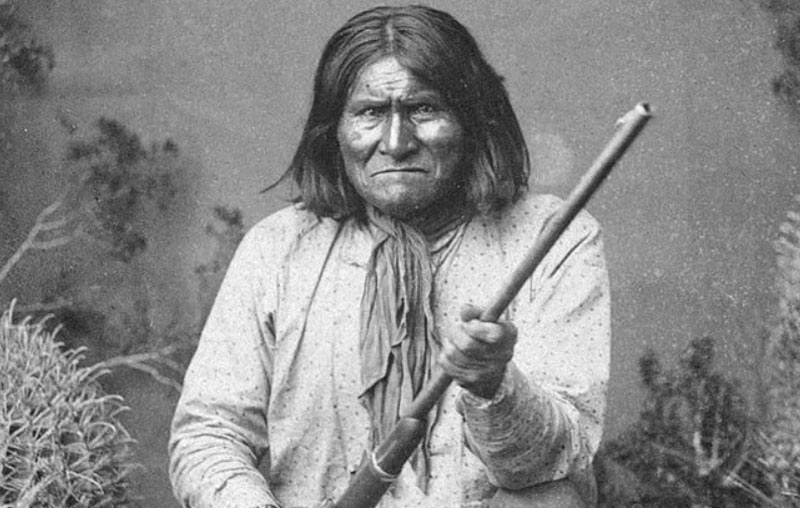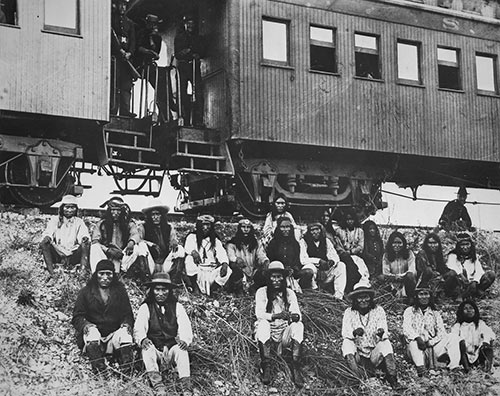Geronimo – Pensacola’s First Major Tourist Attraction

By Katie King
133 years ago this October, a train arrived into the port city of Pensacola, all the way from the wild west, carrying a very famous passenger.
His name was Geronimo. He was a legendary Apache warrior and leader.
But unlike most visitors to our shores, Geronimo certainly did not come to Pensacola for it’s beautiful, sugar-white beaches.
On October 25, 1886, 16 Chiricahua Apache warriors were captured by the U.S. government and sent to Fort Pickens on the edge of Pensacola Beach where they were locked behind bars.
This is a lesser-known chapter in our American history books.
After the Civil War ended, the U.S. Government brought its military to bear against the native peoples out west, removing them from their lands, forcing them onto reservations and then continually constricting those reservations.
The Apache natives were known as fierce warriors, and the government’s policy of removal and confinement naturally led to many deadly confrontations in the mid 1870s. Facing the loss of their homelands, bands of Apaches who were once hostile to one another were now forced together, united in their distrust of the American government due to broken promises. As conditions on the reservation worsened, some bands escaped.
 The famous Chiricahua Apache Geronimo Goyathlay (“one who yawns”) led one such band.
The famous Chiricahua Apache Geronimo Goyathlay (“one who yawns”) led one such band.
In the mid 1870s Geronimo fled his reservation with a band of followers and spent the next 10 years raiding with his band. They raided across New Mexico, Arizona and northern Mexico, successfully evading nearly a quarter of the U.S. Army’s cavalry in that time.
Geronimo and his fugitives’ exploits were highly chronicled by the press. He soon became the most feared Apache and the top target of the Army. His capture even became a personal mission of the President of the United States.
In 1885, Geronimo and some 135 Apache men, women and children left their reservation for the final time. Then in his 60s, Geronimo remained as determined as ever, often pushing his group to cover as much as 70 miles per day to avoid the American cavalry on their trail and raiding countless Mexican and American settlements along the way.
By 1886, the famed warrior’s band was being pursued by 5,000 U.S. soldiers as well as some 3,000 Mexicans. Geronimo was able elude both forces for over five months, but by August, he and his followers had grown weary of life on the run.
On September 4, 1886, Geronimo finally gave himself up to General Nelson Miles at Skeleton Canyon, Arizona. In laying down his arms, he became the last Indian leader to formally surrender to the United States military.
In the following weeks, the Chiricahua Apache were shipped by rail to Florida where they were to be exiled and held as prisoners.
Initially, Geronimo’s band was to be sent to Fort Marion in St. Augustine. Hoping to capitalize on Geronimo’s fame, several prominent Pensacola business leaders lobbied the government to have Geronimo’s group sent to Fort Pickens on Pensacola Beach instead. The petitioners stated Fort Marion was too crowded, and that Army troops from Fort Barrancas could guard Geronimo’s warriors at Fort Pickens.
On October 25, 1886, 16 Apache warriors arrived to Pensacola and were ferried to Fort Pickens. Their wives and children were sent on to Fort Marion in St. Augustine.
 By February 1887, tourists from all across the country were arriving in Pensacola by train to visit the fort and see the prisoners. Admission was 50 cents for adults and 25 cents for children. On one recorded Sunday, 459 tourists visited the fort. Geronimo had become a sideshow spectacle.
By February 1887, tourists from all across the country were arriving in Pensacola by train to visit the fort and see the prisoners. Admission was 50 cents for adults and 25 cents for children. On one recorded Sunday, 459 tourists visited the fort. Geronimo had become a sideshow spectacle.
Geronimo and his warriors spent nearly two years at Fort Pickens working manual labor. In May 1887, the wives and children of Geronimo’s band were returned to them, but many had died of malaria while in confinement. Eventually the imprisoned Apaches were moved to Mount Vernon, Ala., due to a yellow fever scare, and then later on to Fort Sill in the Oklahoma Territory.
Geronimo spent the last 23 years of his life as a prisoner of war until his death from pneumonia in 1909. In 1913, after 27 years of imprisonment, the Chiricahua Apaches were finally set free and were no longer prisoners-of-war. One-third opted to stay at Fort Sill, while two-thirds moved to the Mescalero Apache Reservation, in New Mexico.
Geronimo and the Chiricaua Apache’s resistance came at a steep cost. The Chiricahua lost loved ones, their lands, their traditional ways of life, and for 27 years their freedom. During Geronimo’s prime, the Chiricahua Apache had numbered 1,200. At the end of the war, in 1886, they numbered 500. By their release in 1913, they numbered only 261.
Historians would later come to define Geronimo’s legacy as one of the most legendary warriors in American history.
Today, Geronimo’s story of continued resistance against tremendous odds continues to inspire thousands of visitors to Fort Pickens every year. There are now over 850 Chiricahua Apache living in the U.S., and the descendants of Geronimo and his band still live on.
To explore Fort Pickens and experience a part of Pensacola’s storied history, visit the Gulf Islands National Seashore website here. Plan your visit today.

